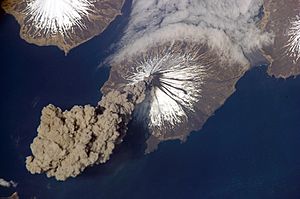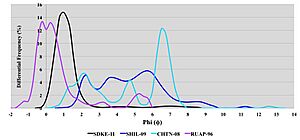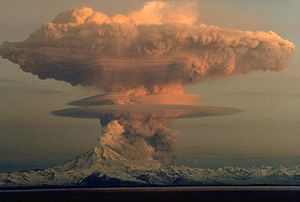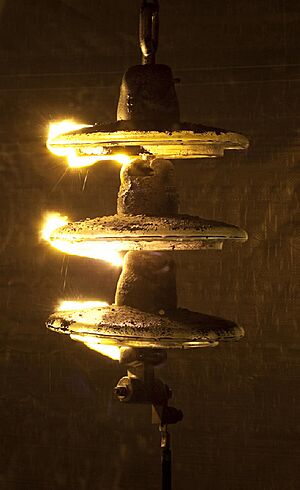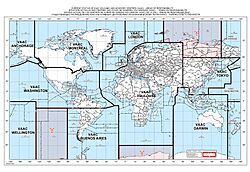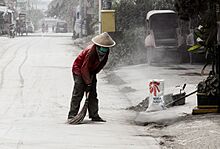Volcanic ash facts for kids



Volcanic ash is made of tiny pieces of rock, minerals, and volcanic glass. It forms during volcanic eruptions and is smaller than 2 millimeters (about the size of a grain of sand). Sometimes, people use "volcanic ash" to mean all explosive eruption materials, even bigger ones, which are correctly called tephra.
Volcanic ash forms when hot, melted rock (called magma) has gases trapped inside it. When these gases escape violently, they shatter the magma into tiny bits. These bits then cool and become solid ash particles. Ash can also form when magma touches water, causing the water to explode into steam and break the magma apart. Once in the air, wind can carry ash for thousands of kilometers.
Because ash spreads so widely, it can affect many things. It can impact people and animals, stop airplanes from flying, and damage important systems like electricity, phones, and water pipes. It can also harm farms and buildings.
Contents
How Volcanic Ash Forms
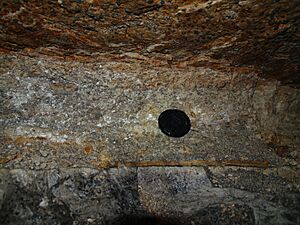
Volcanic ash forms mainly during two types of eruptions: explosive eruptions and phreatomagmatic eruptions. It can also form when hot ash and gas clouds (called pyroclastic density currents) move quickly.
Explosive Eruptions
Explosive eruptions happen when magma rises to the surface and the gases dissolved in it (like water vapor and carbon dioxide) expand quickly. As more gas bubbles form, the magma becomes like a foam. When these bubbles take up a lot of space, they violently tear the magma apart. This sends tiny pieces of magma into the air, where they cool and become ash particles. This process is very good at making fine ash, even without water.
Phreatomagmatic Eruptions
Ash also forms during phreatomagmatic eruptions. These happen when magma touches water, such as the sea, lakes, groundwater, snow, or ice. Magma is much hotter than boiling water. When it touches water, a layer of steam forms around it, like a cushion. This steam layer eventually collapses, and the hot magma directly touches the cold water. This causes the water to expand very quickly and explode, breaking the magma into small ash particles. This process creates even more contact between magma and water, leading to more ash.
Pyroclastic Density Currents
Pyroclastic density currents are fast-moving clouds of hot gas and ash. They can form when a lava dome collapses or when an eruption column falls down. Inside these currents, ash particles crash into each other. This grinding action breaks them into even smaller, finer ash particles. This process creates a lot of very fine ash, which can then rise into the air as a separate ash plume.
The type of eruption affects the ash's features. Volcanoes have different eruption styles based on the magma's makeup, temperature, and gases. Scientists use the Volcanic Explosivity Index (VEI) to measure how powerful an eruption is. For example, gentle eruptions (VEI 1) produce less ash, while very explosive eruptions (VEI 5+) can send huge amounts of ash into the atmosphere.
Properties of Volcanic Ash

Volcanic ash has different properties depending on the volcano and eruption.
Chemical Properties
The minerals in volcanic ash depend on the magma it came from. Magma mainly contains silicon and oxygen. So, different types of ash are often described by how much silica they contain.
- Ash from less explosive eruptions (like basalt) is usually dark and has about 45–55% silica. It's rich in iron and magnesium.
- Ash from very explosive eruptions (like rhyolite) is light-colored and has more than 69% silica.
- Other types of ash (like andesite or dacite) have a silica content between 55% and 69%.
Volcanoes also release gases like water, carbon dioxide, and sulfur dioxide. Some of these gases and other elements can stick to the surface of ash particles. When fresh ash gets wet, it can release salts, mainly chloride and sulfate compounds. These salts can make the ash electrically conductive when wet. This is important because it can affect power systems.
Physical Properties
What Ash is Made Of
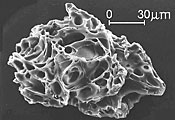
Volcanic ash particles can be made of different things:
- Glassy parts: These are non-crystalline, like tiny pieces of glass.
- Crystal parts: These are tiny mineral crystals.
- Rock parts: These are small pieces of older rock.
Ash from less sticky magma (like basalt) can form different shapes, from tiny glass droplets to blocky pieces. Ash from very sticky magma (like rhyolite) often consists of crushed pumice (glassy shards), individual crystals, and some rock fragments.
Ash from eruptions where magma touches water often contains altered rock and mineral pieces, sometimes in a clay-like material.
Shape of Ash Particles
The shape of volcanic ash particles depends on how they formed.
- Ash from runny magma (like basalt) often forms droplet shapes. These can be perfect spheres or twisted, elongated droplets with smooth surfaces.
- Ash from sticky magma (like rhyolite) often has shapes based on the gas bubbles in the magma before it broke apart. These particles can have many holes and rough surfaces.
- Ash from eruptions where magma touches water often forms blocky or pyramid-shaped glass particles.
Density and Hardness
The density of ash particles varies. Pumice is lighter (700–1200 kg/m³), while glass shards, crystals, and rock pieces are denser (2350–3300 kg/m³). Denser, larger particles fall closer to the volcano. Fine glass and pumice shards travel farther.
Volcanic ash is also quite hard (around 5 on the Mohs Hardness Scale) and often has sharp, angular edges. This makes some types of ash, especially those high in silica, very abrasive, meaning they can wear things down.
Grain Size
Volcanic ash particles are smaller than 2 millimeters. They can be as tiny as 1 micrometer (one-thousandth of a millimeter). The size of ash particles can vary a lot. Magmas that are more sticky (like rhyolite) usually produce finer ash because they are more explosive.
How Ash Spreads
Ash particles are shot out of the volcano at high speed into eruption columns. The force of the eruption pushes the column up. As air mixes in, the column becomes lighter and floats higher into the atmosphere. When the column reaches a height where its density matches the surrounding air, it stops rising and starts to spread sideways.
Wind then carries the ash. Ash can travel hundreds or thousands of kilometers from the volcano. How far it goes depends on how high the eruption column was, the size of the ash particles, and the wind direction and strength.
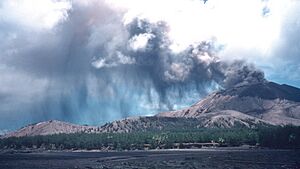
Ash starts to fall out of the sky soon after the eruption. Heavier, larger particles fall first, closer to the volcano. Smaller particles can stay in the air for days or weeks, carried by high-altitude winds. These fine particles can affect air travel and, along with volcanic gases, can even change the global climate.
Ash plumes can also form above fast-moving pyroclastic density currents. These plumes often have more fine ash because the particles grind against each other within the current.
Impacts of Volcanic Ash
More and more people live closer to volcanoes, which means more people are at risk from ash fall.
Even a few millimeters or centimeters of ash can cause big problems. It can stop transportation, electricity, water, and sewage systems. Businesses can lose money, and damaged parts need to be replaced. Ash fall can also cause many other problems across different areas of society.
The effects of ash fall depend on:
- How thick the ash layer is.
- The size and chemicals in the ash.
- Whether the ash is wet or dry.
- How long the ash falls.
- How well people and communities are prepared to deal with it.
Different parts of society are affected in different ways.
Human and Animal Health
Ash particles smaller than 10 micrometers can be breathed in. People exposed to ash falls might have trouble breathing, eye and skin irritation, and nose and throat problems. Most of these effects are short-term and usually not serious for healthy people. However, they can be worse for those with existing breathing problems. The health effects depend on the ash's size, minerals, and chemical coatings.
Long-term health effects are possible, especially from breathing in tiny bits of silica found in some ash. This can cause a lung disease called silicosis. However, there have been no proven cases of silicosis caused by volcanic ash exposure.
Drinking Water and Animals
For large water sources like lakes, the ash usually doesn't cause major problems for drinking water. However, elements like iron and manganese can make the water taste metallic or stain things, but they are not a health risk.
Rainwater collected from roofs is very easily contaminated by ash. Chemicals from the ash can leach into the water, making it unsafe to drink. It's best to disconnect downpipes before an ash fall to protect stored water. Ash can also make rainwater more acidic, which can cause problems with metal pipes.
Ash can be harmful to livestock (farm animals).
- It can wear down their teeth.
- If the ash has high levels of fluorine, animals can get fluorine poisoning. For example, after an eruption in New Zealand, many sheep died from fluorine poisoning after eating grass covered in just a few millimeters of ash.
- Eating ash can also block their stomachs and intestines.
- Ash can make sheep's wool very heavy, especially when wet, making it hard for them to stand.
Infrastructure
Electricity
Volcanic ash can cause problems for electricity systems:
- Wet ash on power line insulators can cause electricity to jump across them (called 'flashover'). This can lead to power outages.
- Ash can wear down moving parts in power plants, like turbines and cooling fans.
- Heavy ash can break power lines and damage towers, especially when wet. Fine ash sticks easily to lines.
- Sometimes, power companies might turn off electricity in certain areas to prevent damage or to clean equipment safely.
Drinking Water Supplies
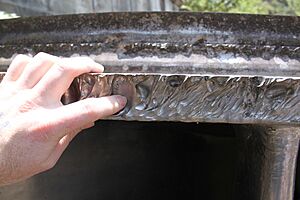
Water systems that get water from underground wells are usually safe from ash fall. However, ash can affect pumps. Power outages can also stop electric pumps from working if there's no backup power.
Ash can block water intake pipes and damage pumps at water treatment plants. It can also get into filters. Usually, this means more cleaning and maintenance, but not always a complete stop in water service.
It's important that drinking water is clean and free of germs. Ash particles can protect germs from cleaning chemicals like chlorine, so water treatment plants might need to use more chlorine.
During ash falls, people often use a lot of water for cleaning, which can lead to water shortages. This can affect important services like firefighting.
Wastewater Treatment
Ash can also damage wastewater systems. It's hard to keep ash out of sewer pipes, especially if they are connected to storm drains. Ash can block screens and other equipment at wastewater treatment plants. It can also settle in tanks, reducing their capacity and changing the sludge.
Aircraft
Flying through volcanic ash clouds is very dangerous for airplanes.
- Ash can scratch windshields and lights, making it hard for pilots to see.
- Sensors on the plane can get blocked, giving wrong readings.
- Ash entering jet engines can damage the fan blades.
- The ash can melt in the hot parts of the engine and then turn into solid glass on other parts, blocking airflow and causing the engine to stop.
If an engine stalls, the pilot's usual reaction is to increase power, but this makes the problem worse with ash. Pilots are taught to reduce power and quickly turn around to leave the ash cloud. Volcanic gases in ash clouds can also damage engines and windows.
Past Incidents
There have been many cases of airplanes being damaged by ash.
- In 1982, a British Airways Boeing 747 flew through ash from Mount Galunggung in Indonesia, and all four engines stopped. The plane dropped thousands of feet before the engines restarted.
- In 1989, a KLM Boeing 747 also lost power to all four engines after flying into ash from Mount Redoubt, Alaska. It dropped over 4,500 meters before the engines restarted just before impact. This caused US$80 million in damage.
- The 1991 eruption of Mount Pinatubo in the Philippines caused over US$100 million in damage to airplanes.
In April 2010, airspace across Europe was closed because of ash from the Eyjafjallajökull volcano in Iceland. Many flights were canceled. In June 2011, similar closures happened in South America and Oceania after the Puyehue-Cordón Caulle eruption in Chile.
Detecting Ash Clouds
Volcanic ash clouds are hard for pilots to see because there are no instruments in the cockpit to detect them. However, a new system called AVOID (Airborne Volcanic Object Infrared Detector) has been developed. It uses special infrared cameras to detect ash plumes up to 60 kilometers ahead, giving pilots time to fly around them safely.
Also, scientists use ground-based and satellite images, radar, and lidar to find ash clouds. This information is shared through nine Volcanic Ash Advisory Centers (VAAC) around the world, which warn airlines about ash clouds.
Airport Systems
Volcanic ash also affects airports on the ground. Even small amounts of ash can reduce visibility, make runways slippery, get into communication and electrical systems, and damage buildings and parked aircraft. If more than a few millimeters of ash falls, it must be removed before airports can fully operate again. Ash doesn't melt like snow, so it needs to be cleaned up and properly disposed of to prevent it from being blown around again.
Land Transport
Ash can disrupt roads, vehicles, railways, and ports for hours or days. Falling ash reduces visibility, making driving dangerous. Cars driving fast can stir up ash, creating more dust clouds. Ash on roads reduces tire grip, especially when wet, and can cover road markings. Fine ash can get into car engines and wear down moving parts. Air and oil filters will get blocked and need frequent changing. Trains are less affected, mainly by reduced visibility.
Ships can also be impacted. Ash can block filters and damage engines if it gets inside. Visibility is also reduced during ash fall. Light, porous ash (like pumice) can float on water in "pumice rafts," which can clog water intakes and cause engines to overheat.
Communications
Phone and broadcast systems can be affected by ash. Ash can weaken signals and damage equipment.
- Equipment like air conditioning units, which keep modern electronics cool, can get blocked by ash, making them less efficient.
- Heavy ash falls can cause phone lines, masts, and antennae to collapse.
- Wet ash can also cause metal parts to rust faster.
The biggest problem for communication networks during disasters is often too many people trying to use them at once, overloading the system.
Computers
Computers can be affected by volcanic ash, but they usually don't completely break down. The most vulnerable parts are moving ones like cooling fans, CD drives, keyboards, and mice. Fine ash can jam these parts, but they can often be fixed by cleaning with compressed air. Wet ash can cause electrical problems in desktop computers, but not usually in laptops.
Buildings and Structures
Damage to buildings can range from roofs collapsing to less serious damage to outside and inside materials. The impact depends on ash thickness, whether it's wet, the roof design, and how much ash gets inside. Wet ash can be 50–100% heavier than dry ash. Ash loading is similar to snow, but ash is usually much heavier, doesn't melt, and can clog gutters.
Flat roofs are more likely to collapse than steeply sloped ones. Smooth roofs (metal or glass) shed ash better than rough ones (thatch or shingles). Roof collapses from ash can cause many injuries and deaths. For example, about 300 people died when roofs collapsed during the 1991 Mount Pinatubo eruption.
Environment and Agriculture
Volcanic ash can harm the environment in ways that are hard to predict.
- Natural waterways can be affected like urban water systems. Ash makes water cloudy, reducing sunlight for underwater plants and affecting fish. It can also make water more acidic and, if it contains fluoride, contaminate it.
Ash accumulation also affects farms, plants, and trees.
- Thin ash falls (less than 20 millimeters) might make livestock not want to eat. They can also slow down plant growth and photosynthesis. Sometimes, a thin layer of ash can even help plants grow by acting as a mulch or fertilizer.
- Heavier ash falls will completely bury pastures and soil, killing plants and making the soil unhealthy because it lacks oxygen. Plant survival depends on ash thickness, ash type, how much it rains, and how long plants are buried.
Young forests (trees less than 2 years old) are most at risk and can be destroyed by ash layers thicker than 100 millimeters. Older trees usually survive, but heavy ash (over 500 millimeters) can break large branches. Trees might also lose their leaves, especially if the ash is coarse.
After ash fall, land can be restored. This might involve planting new seeds, mixing the ash with the soil, removing the ash, or adding new topsoil.
How Everything is Connected
Important systems like medical care, police, emergency services, and basic needs like water, power, and transportation are all connected. If one system is damaged by ash, it can affect many others. For example, hospitals need electricity and water to work.
The 2010 Eyjafjallajökull eruption in Iceland showed how much modern society relies on these systems. The airline industry lost billions of dollars because European airspace was closed for days. Ash also caused local crop losses, hurt tourism, and damaged roads and bridges in Iceland. But the effects spread worldwide, impacting shipping, postal services, and trade, showing how connected everything is.
Preparedness and Management
Being prepared for ash falls means sealing buildings, protecting homes and important systems, and having enough food and water for a few days.
- Wearing Dust masks can help you avoid breathing in ash.
- Goggles can protect your eyes.
- At home, know what to do and have a plan for where to go if needed.
- Keep items like flashlights, plastic sheets (to cover electronics), and battery-powered radios handy.
Before an ash fall, communities should plan how to communicate and what actions to take. Having spare parts and backup systems for critical services helps reduce disruptions. It's also important to know where to dispose of ash before it falls, so it doesn't get blown around again.
Good ways to manage ash include:
- Cleaning methods and tools.
- Covering openings like air vents, water intakes, and aircraft engines during ash fall.
- Closing roads or limiting speed to prevent car problems.
- Unblocking drains and preventing ash from entering water systems.
- Lightly wetting ash (not soaking it) to stop it from blowing away and make cleanup easier.
- Prioritizing cleanup for important places and coordinating efforts.
It is recommended to move livestock out of areas where ashfall might be 5 centimeters or more thick.
Volcanic Ash Soils
Volcanic ash is very good for soil. When rain washes the minerals from ash into the ground, it mixes with the soil and forms a special layer called an andisol. This soil is very rich in nutrients like phosphorus and nitrogen, which are great for farming. This is why volcanic islands often have lush forests and good farmland. Volcanic ash can also be used as a replacement for sand in some cases.
See also
 In Spanish: Ceniza volcánica para niños
In Spanish: Ceniza volcánica para niños
- Bentonite
- Deposition (aerosol physics)
- Energetically modified cement
- NOTAM
- Roman concrete
- Tephrochronology
- Volcanic ash aggregation


